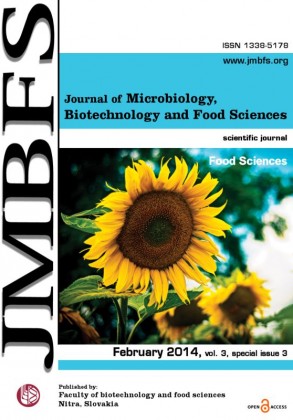BEHAVIOR OF CRACKED EGGS AT NON – DESTRUCTIVE IMPACT
Keywords:
Eggshell, impact loading, frequency analysis, crack, eggAbstract
The influence of cracks on the dynamical frequency response of eggshells was studied. The non-destructive impact tests of the intact and cracked eggs were performed. Record of impact force time history was enabled by experimental device. Response of eggshell to the impact was described by the surface displacement of the eggshell. This response was measured by the laser interferometry. The force and response were also expressed in the frequency domain using of the fast Fourier transform. Both time and frequency response were affected by the presence of cracks. It was shown that the influence of cracks on the eggshell response was more effectively described in the frequency domain. The frequency response was relatively very sensitive to the position and orientation of cracks. The frequency response function was characterized by many peaks. Five excitation resonant frequency characteristic of signals were extracted based on the difference of frequency domain response signals. Distinction between intact and cracked eggs was enabled by these parameters. Even if some main problems were solved some of them remained unsolved. One of them was the effect of the impacting body r shape. This problem could be effectively solved namely using of numerical methods. In order to describe the response of eggshell response to the non-destructive impact using of the numerical simulation exact description of eggshell shape was performed. This numerical simulation will be subject of forthcoming paper.Downloads
Download data is not yet available.
Downloads
Published
2014-02-01
How to Cite
Strnková, J., Nedomová, Šárka, Trnka, J., Buchar, J., & Simeonovová, J. (2014). BEHAVIOR OF CRACKED EGGS AT NON – DESTRUCTIVE IMPACT. Journal of Microbiology, Biotechnology and Food Sciences, 3(special issue 3 (Food Sciences), 43–50. Retrieved from https://office2.jmbfs.org/index.php/JMBFS/article/view/7570
Issue
Section
Food Sciences
License
Copyright (c) 2014 Jana Strnková, Šárka Nedomová, Jan Trnka, Jaroslav Buchar, Jana Simeonovová

This work is licensed under a Creative Commons Attribution 4.0 International License.
All papers published in the Journal of Microbiology, Biotechnology and Food Sciences are published under a CC-BY licence (CC-BY 4.0). Published materials can be shared (copy and redistribute the material in any medium or format) and adapted (remix, transform, and build upon the material for any purpose, even commercially) with specifying the author(s).

